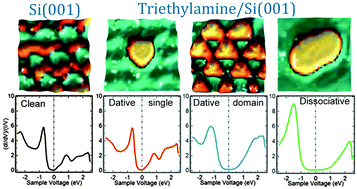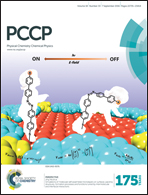Room temperature differential conductance measurements of triethylamine molecules adsorbed on Si(001)
Abstract
We have measured the differential conductance of the triethylamine molecule (N(CH2CH3)3) adsorbed on Si(001)-2 × 1 at room temperature using scanning tunneling spectroscopy. Triethylamine can be engaged in a dative bonding with a silicon dimer, forming a Si–Si–N(CH2CH3)3 unit. We have examined the datively bonded adduct, either as an isolated molecule, or within an ordered molecular domain (reconstructed 4 × 2). The differential conductance curves, supported by DFT calculations, show that in the explored energy window (±2.5 near the Fermi level) the main features stem from the uncapped dangling bonds of the reacted dimer and of the adjacent unreacted ones that are electronically coupled The formation of a molecular domain, in which one dimer in two is left unreacted, is reflected in a shift of the up dimer atom occupied level away from the Fermi level, likely due to an increased π-bonding strength. In stark contrast with the preceding, pairs of dissociated molecule (a minority species) are electronically decoupled from the dimer dangling bond states. DFT calculation show that the lone-pair of the Si–N(CH2CH3)2 is a shallow level, that is clearly seen in the differential conductance curve.



 Please wait while we load your content...
Please wait while we load your content...